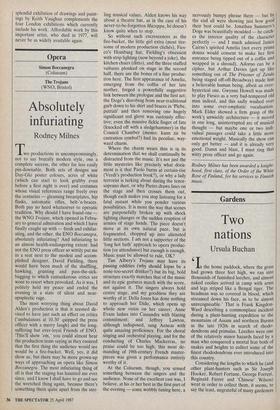Gardens
Two nations
Ursula Buchan
the home paddock, where the grass had grown three feet high, we ran into thousands of famished leeches, and almost naked coolies arrived in camp with arms and legs striped like a Bengal tiger. The headman was so covered in blood, which streamed down his face, as to be almost unrecognisable.' That is Frank Kingdon- Ward describing a commonplace incident during a plant-hunting expedition to the mountains of Assam and northern Burma in the late 1920s in search of rhodo- dendrons and primulas. Leeches were one of the relatively minor hazards faced by a man who conquered a mortal fear both of snakes and heights to collect some of the finest rhododendrons ever introduced into this country. Considering the lengths to which he (and other plant-hunters such as Sir Joseph Hooker, Robert Fortune, George Forrest, Reginald Farrer and 'Chinese' Wilson) went in order to collect them, it seems, to say the least, ungrateful of many gardeners to be so dismissive of rhododendrons.
We are two nations separated by a common interest in gardening. Cultivators of alkaline soils recognise but do not really understand the language of those who have a pH of 6.5 or less. This lack of under- standing leads to prejudice. 'How I dislike rhododendrons — great, coarse things I'm so glad I can't grow them.' As with Guinness, we (I have a pH of 7.7) do not like them because we have never tried them. Thus a whole order of plants (which rival in size and splendour even the orchids and the roses) is consigned to the outer darkness of our indifference.
If we think of rhododendrons (which is rarely) it is to Rhododendron ponticum that our minds turn, then quickly turn away. This shrub (which masses along the margins of every dark driveway in Scot- land) has sickly mauve (known as rosy- purple in the catalogues) flowers above dank, undistinguished, evergreen leaves, and imperialistic tendencies of which Tamerlane might have been proud. But then R. ponticum is not popular these days with anyone. It may be useless to point out to the unbeliever the impact of a well-grown `Beauty of Littleworth' with its huge white flowers, or the perfect, dark crimson, Waxy, elongated bells of R. cinnarbarinum var. roylei `Magnificum'. Perhaps it is also fruitless to mention the great impression made by a 15-foot specimen of the blood- red R. thomsoni in a woodland glade, or to dwell on the enormous size of the leaves of R. sino-grande. Presumably even talk of the deciduous azalea, R. luteum, with its deep yellow flowers blanketing the bush in May, and a sweet scent so powerful that one can catch a breath of it from inside a closed car, will fall on deaf ears.
If one can be persuaded to like them, there are at least two rhododendrons, surprisingly, which will grow on limey soil. One is 'Cunningham's White', a fine and extremely hardy, but uninvasive, ponticum hybrid which grows up to 10 feet tall and has masses of flowers which start faintly mauve but become pure white save for a little yellow speckling in the throat. This can be used as covert-planting for those with a 'shoot' to maintain who wish for something other than the ubiquitous snow- berry to please the pheasants. The other is a small alpine shrub with dark pink flowers called R. hirsutum.
There exists an 'ericaceous' planting compost, which will satisfy the craving for acid conditions which is the hallmark of the Ericaceae, the family name of rho- dodendrons and heathers. There is no reason, for example, why we who live on alkaline soil should not grow the small, neat, compact 'yaks' (the cognoscenti's word for the forms and hybrids of R. yakushimanum) or R. moupinense in large pots or tubs. Separated by a cordon sani- taire from alkaline soil, watered with rainwater rather than with tap water (which in East Northamptonshire, at least, is as hard as an ungrateful heart) there is no reason why the leaves should ever yellow. If they do, spraying with an iron chelate like `Sequestrene' (which tempor- arily unlocks the grip of calcium on iron in an alkaline soil so that it becomes available to the plant) will soon put matters to rights. Even if you cannot, or do not wish to, grow rhododendrons or azaleas it seems a pity never to take the opportunity to look at them. I am taking my own advice (for once) and spending some days next week on the west coast of Scotland in order to see Scottish glens transformed into Hima- layan gorges. The unconvinced might like to begin with a tour of the Savill Garden in Windsor Great Park or the RHS gardens at Wisley in Surrey, or one of the large rhododendron gardens of Sussex such as Leonardslee. The Cornwall Garden Socie- ty is celebrating its 75th anniversary with a particularly large and splendid flower show and gardens festival to be held at Trelis- sick , near Truro, this weekend. It is the mid-point of a fortnight when many Cor- nish gardens are opening in succession from west to east, a few each day. There will be plenty of Himalayan introductions to see and even, perhaps, admire — but no leeches.



































































 Previous page
Previous page